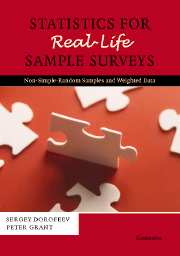Book contents
- Frontmatter
- Contents
- Preface
- 1 Sampling methods
- 2 Weighting
- 3 Statistical effects of sampling and weighting
- 4 Significance testing
- 5 Measuring relationships between variables
- Appendix A Review of general terminology
- Appendix B Further reading
- Appendix C Summary tables for several common distributions
- Appendix D Chapter 2 mathematical proofs
- Appendix E Chapter 3 mathematical proofs
- Appendix F Chapter 4 mathematical proofs
- Appendix G Chapter 5 mathematical proofs
- Appendix H Statistical tables
- References
- Index
Appendix A - Review of general terminology
Published online by Cambridge University Press: 18 August 2009
- Frontmatter
- Contents
- Preface
- 1 Sampling methods
- 2 Weighting
- 3 Statistical effects of sampling and weighting
- 4 Significance testing
- 5 Measuring relationships between variables
- Appendix A Review of general terminology
- Appendix B Further reading
- Appendix C Summary tables for several common distributions
- Appendix D Chapter 2 mathematical proofs
- Appendix E Chapter 3 mathematical proofs
- Appendix F Chapter 4 mathematical proofs
- Appendix G Chapter 5 mathematical proofs
- Appendix H Statistical tables
- References
- Index
Summary
For convenience, we present a short list of elementary statistical terms and formulae.
Statistics as a science deals with mathematical methods of collecting, summarising and analysing data and presenting results of analysis in a mathematical form.
A population (sometimes called a universe) is a set of objects to be studied. The purpose of a statistical analysis is to draw conclusions about a population. In most cases, statistics is concerned with a particular population characteristic called a parameter of the population.
Statistical methods can be applied (only) in situations when it is impracticable or impossible to collect information about all objects in the population but the information is available for a subset of the population called a sample. The process of estimating or predicting population parameters using sample data is called statistical inference.
A sample is described as representative if it is believed that it fairly and comprehensively represents the population from which it is drawn. A sample is biased if it over-represents or under-represents a particular population group. The words ‘unbiased’ and ‘representative’ are usually interchangeable. Both are relative terms, not absolute. Except in highly artificial situations no sample will be representative in every respect. The terms are sometimes used to describe the intentions of the sampler or the design of the sample rather than the outcome.
- Type
- Chapter
- Information
- Statistics for Real-Life Sample SurveysNon-Simple-Random Samples and Weighted Data, pp. 227 - 236Publisher: Cambridge University PressPrint publication year: 2006



